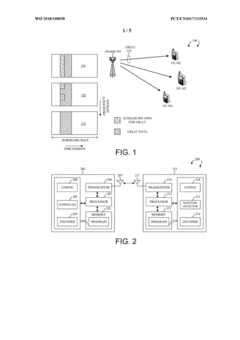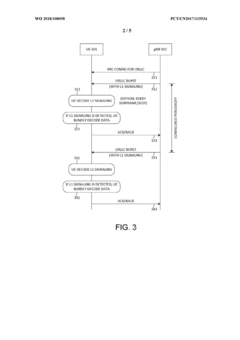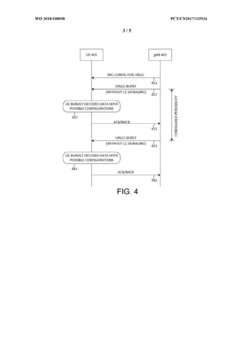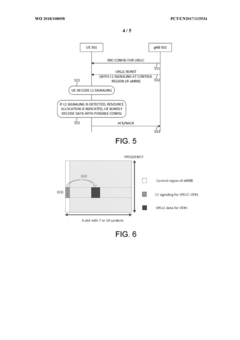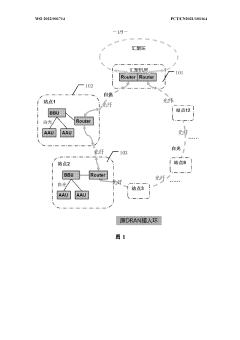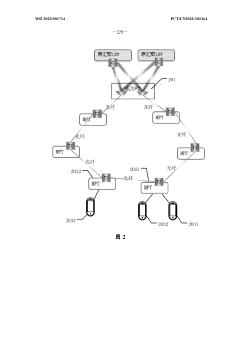How 5G UC Supports Real-Time Data Transmission in Aerospace Engineering
JUL 18, 20259 MIN READ
Generate Your Research Report Instantly with AI Agent
Patsnap Eureka helps you evaluate technical feasibility & market potential.
5G UC in Aerospace: Background and Objectives
The aerospace industry has witnessed significant technological advancements over the years, with real-time data transmission becoming increasingly crucial for efficient operations and safety. The emergence of 5G Ultra-Capacity (UC) technology marks a pivotal moment in this evolution, promising to revolutionize the way aerospace engineering handles data communication.
5G UC, an advanced iteration of fifth-generation cellular technology, offers unprecedented capabilities in terms of speed, capacity, and low latency. These features are particularly relevant to the aerospace sector, where the ability to transmit and process vast amounts of data in real-time can significantly enhance various aspects of aircraft design, manufacturing, maintenance, and operation.
The primary objective of implementing 5G UC in aerospace engineering is to enable seamless, high-speed, and reliable real-time data transmission across all phases of aircraft lifecycle. This technology aims to support critical applications such as in-flight diagnostics, predictive maintenance, and enhanced situational awareness for pilots and ground crews.
Historically, the aerospace industry has relied on a combination of satellite communications, radio frequency systems, and wired networks for data transmission. While these technologies have served the industry well, they often fall short in meeting the increasing demands for bandwidth, speed, and reliability required by modern aerospace applications.
The evolution of cellular technologies from 1G to 4G has gradually improved data transmission capabilities, but it is the leap to 5G UC that truly aligns with the aerospace industry's needs for real-time, high-volume data processing. This technology is expected to play a crucial role in enabling the next generation of smart, connected aircraft and supporting infrastructure.
Key technological trends driving the adoption of 5G UC in aerospace include the Internet of Things (IoT), artificial intelligence, and edge computing. These trends collectively contribute to the creation of a more interconnected and intelligent aerospace ecosystem, where real-time data can be leveraged to optimize performance, enhance safety, and improve operational efficiency.
As we explore the potential of 5G UC in aerospace engineering, it is essential to consider the challenges and opportunities that lie ahead. The integration of this technology will require significant investments in infrastructure, the development of new standards and protocols, and addressing potential security concerns associated with wireless data transmission in critical aerospace applications.
5G UC, an advanced iteration of fifth-generation cellular technology, offers unprecedented capabilities in terms of speed, capacity, and low latency. These features are particularly relevant to the aerospace sector, where the ability to transmit and process vast amounts of data in real-time can significantly enhance various aspects of aircraft design, manufacturing, maintenance, and operation.
The primary objective of implementing 5G UC in aerospace engineering is to enable seamless, high-speed, and reliable real-time data transmission across all phases of aircraft lifecycle. This technology aims to support critical applications such as in-flight diagnostics, predictive maintenance, and enhanced situational awareness for pilots and ground crews.
Historically, the aerospace industry has relied on a combination of satellite communications, radio frequency systems, and wired networks for data transmission. While these technologies have served the industry well, they often fall short in meeting the increasing demands for bandwidth, speed, and reliability required by modern aerospace applications.
The evolution of cellular technologies from 1G to 4G has gradually improved data transmission capabilities, but it is the leap to 5G UC that truly aligns with the aerospace industry's needs for real-time, high-volume data processing. This technology is expected to play a crucial role in enabling the next generation of smart, connected aircraft and supporting infrastructure.
Key technological trends driving the adoption of 5G UC in aerospace include the Internet of Things (IoT), artificial intelligence, and edge computing. These trends collectively contribute to the creation of a more interconnected and intelligent aerospace ecosystem, where real-time data can be leveraged to optimize performance, enhance safety, and improve operational efficiency.
As we explore the potential of 5G UC in aerospace engineering, it is essential to consider the challenges and opportunities that lie ahead. The integration of this technology will require significant investments in infrastructure, the development of new standards and protocols, and addressing potential security concerns associated with wireless data transmission in critical aerospace applications.
Aerospace Industry Demand for Real-Time Data Transmission
The aerospace industry has witnessed a growing demand for real-time data transmission capabilities, driven by the need for enhanced safety, efficiency, and performance in aircraft operations. This demand stems from various factors, including the increasing complexity of modern aircraft systems, the rise of connected and autonomous aerospace technologies, and the push for more data-driven decision-making processes.
One of the primary drivers for real-time data transmission in aerospace engineering is the need for continuous monitoring and analysis of aircraft performance. Modern aircraft generate vast amounts of data from numerous sensors and systems, covering everything from engine performance to environmental conditions. Real-time transmission of this data allows for immediate analysis and response, enabling proactive maintenance, improved fuel efficiency, and enhanced safety measures.
The advent of connected aircraft concepts has further intensified the demand for real-time data transmission. Airlines and aerospace companies are increasingly looking to leverage connectivity to improve operational efficiency, passenger experience, and overall fleet management. This includes real-time updates on flight conditions, weather patterns, and air traffic, allowing for dynamic route optimization and improved decision-making.
In the realm of aircraft maintenance, real-time data transmission plays a crucial role in predictive maintenance strategies. By continuously monitoring aircraft systems and components, potential issues can be identified and addressed before they escalate into more serious problems. This approach not only enhances safety but also reduces maintenance costs and minimizes aircraft downtime.
The growing interest in autonomous and remotely piloted aircraft systems has also contributed to the increased demand for real-time data transmission. These systems rely heavily on continuous, low-latency data exchange for navigation, obstacle avoidance, and mission execution. As the aerospace industry explores more advanced autonomous capabilities, the need for robust, reliable real-time data transmission becomes even more critical.
Furthermore, the aerospace industry's focus on enhancing passenger experience has led to a surge in demand for high-speed, in-flight connectivity. Airlines are increasingly offering broadband internet access, live television, and other data-intensive services to passengers, necessitating advanced real-time data transmission capabilities.
The demand for real-time data transmission extends beyond commercial aviation to other sectors of the aerospace industry, including space exploration and satellite communications. These areas require ultra-reliable, low-latency data transmission for mission-critical operations, scientific research, and global communication networks.
As the aerospace industry continues to evolve, the demand for real-time data transmission is expected to grow exponentially. This trend is driving innovation in communication technologies, data processing capabilities, and aerospace engineering practices, paving the way for more connected, efficient, and intelligent aerospace systems in the future.
One of the primary drivers for real-time data transmission in aerospace engineering is the need for continuous monitoring and analysis of aircraft performance. Modern aircraft generate vast amounts of data from numerous sensors and systems, covering everything from engine performance to environmental conditions. Real-time transmission of this data allows for immediate analysis and response, enabling proactive maintenance, improved fuel efficiency, and enhanced safety measures.
The advent of connected aircraft concepts has further intensified the demand for real-time data transmission. Airlines and aerospace companies are increasingly looking to leverage connectivity to improve operational efficiency, passenger experience, and overall fleet management. This includes real-time updates on flight conditions, weather patterns, and air traffic, allowing for dynamic route optimization and improved decision-making.
In the realm of aircraft maintenance, real-time data transmission plays a crucial role in predictive maintenance strategies. By continuously monitoring aircraft systems and components, potential issues can be identified and addressed before they escalate into more serious problems. This approach not only enhances safety but also reduces maintenance costs and minimizes aircraft downtime.
The growing interest in autonomous and remotely piloted aircraft systems has also contributed to the increased demand for real-time data transmission. These systems rely heavily on continuous, low-latency data exchange for navigation, obstacle avoidance, and mission execution. As the aerospace industry explores more advanced autonomous capabilities, the need for robust, reliable real-time data transmission becomes even more critical.
Furthermore, the aerospace industry's focus on enhancing passenger experience has led to a surge in demand for high-speed, in-flight connectivity. Airlines are increasingly offering broadband internet access, live television, and other data-intensive services to passengers, necessitating advanced real-time data transmission capabilities.
The demand for real-time data transmission extends beyond commercial aviation to other sectors of the aerospace industry, including space exploration and satellite communications. These areas require ultra-reliable, low-latency data transmission for mission-critical operations, scientific research, and global communication networks.
As the aerospace industry continues to evolve, the demand for real-time data transmission is expected to grow exponentially. This trend is driving innovation in communication technologies, data processing capabilities, and aerospace engineering practices, paving the way for more connected, efficient, and intelligent aerospace systems in the future.
5G UC Technology: Current State and Challenges
5G Ultra-Capacity (UC) technology represents a significant advancement in wireless communication, offering unprecedented data transmission speeds and low latency. In the context of aerospace engineering, 5G UC holds immense potential for revolutionizing real-time data transmission. However, the current state of 5G UC implementation in aerospace applications faces several challenges that need to be addressed.
The primary advantage of 5G UC in aerospace engineering lies in its ability to handle massive amounts of data with minimal delay. This capability is crucial for applications such as real-time telemetry, remote sensing, and in-flight diagnostics. Current implementations have demonstrated data rates of up to 20 Gbps, which is a substantial improvement over previous generations of wireless technology.
Despite these advancements, the aerospace industry faces unique challenges in fully leveraging 5G UC. One of the most significant hurdles is the need for robust and reliable connectivity in extreme environments. Aircraft operate at high altitudes and speeds, which can lead to signal degradation and frequent handovers between base stations. Ensuring seamless connectivity under these conditions remains a technical challenge.
Another critical issue is the integration of 5G UC with existing aerospace communication systems. Many aircraft and ground systems rely on legacy technologies, and the transition to 5G UC requires careful planning and significant infrastructure upgrades. This integration process is complex and costly, posing a barrier to widespread adoption.
Security and privacy concerns also present challenges for 5G UC in aerospace applications. The increased connectivity and data transmission capabilities introduce new vulnerabilities that must be addressed to protect sensitive information and critical systems from cyber threats.
Furthermore, the regulatory landscape for 5G UC in aerospace is still evolving. Different countries have varying regulations regarding spectrum allocation and usage for 5G technology, which can complicate international flights and global aerospace operations. Harmonizing these regulations on a global scale is an ongoing challenge.
The power consumption of 5G UC systems is another area of concern, particularly for battery-powered devices and sensors used in aerospace applications. Developing energy-efficient 5G UC solutions that can operate reliably in aerospace environments is a key focus for researchers and engineers in the field.
Lastly, the aerospace industry must address the challenge of latency in mission-critical applications. While 5G UC offers significantly reduced latency compared to previous generations, certain aerospace applications require even lower latency to ensure safe and efficient operations. Achieving ultra-low latency in all operational scenarios remains an active area of research and development.
The primary advantage of 5G UC in aerospace engineering lies in its ability to handle massive amounts of data with minimal delay. This capability is crucial for applications such as real-time telemetry, remote sensing, and in-flight diagnostics. Current implementations have demonstrated data rates of up to 20 Gbps, which is a substantial improvement over previous generations of wireless technology.
Despite these advancements, the aerospace industry faces unique challenges in fully leveraging 5G UC. One of the most significant hurdles is the need for robust and reliable connectivity in extreme environments. Aircraft operate at high altitudes and speeds, which can lead to signal degradation and frequent handovers between base stations. Ensuring seamless connectivity under these conditions remains a technical challenge.
Another critical issue is the integration of 5G UC with existing aerospace communication systems. Many aircraft and ground systems rely on legacy technologies, and the transition to 5G UC requires careful planning and significant infrastructure upgrades. This integration process is complex and costly, posing a barrier to widespread adoption.
Security and privacy concerns also present challenges for 5G UC in aerospace applications. The increased connectivity and data transmission capabilities introduce new vulnerabilities that must be addressed to protect sensitive information and critical systems from cyber threats.
Furthermore, the regulatory landscape for 5G UC in aerospace is still evolving. Different countries have varying regulations regarding spectrum allocation and usage for 5G technology, which can complicate international flights and global aerospace operations. Harmonizing these regulations on a global scale is an ongoing challenge.
The power consumption of 5G UC systems is another area of concern, particularly for battery-powered devices and sensors used in aerospace applications. Developing energy-efficient 5G UC solutions that can operate reliably in aerospace environments is a key focus for researchers and engineers in the field.
Lastly, the aerospace industry must address the challenge of latency in mission-critical applications. While 5G UC offers significantly reduced latency compared to previous generations, certain aerospace applications require even lower latency to ensure safe and efficient operations. Achieving ultra-low latency in all operational scenarios remains an active area of research and development.
5G UC Solutions for Real-Time Aerospace Data Transmission
01 Network slicing for URLLC
Network slicing is utilized to create dedicated virtual networks for URLLC applications, ensuring ultra-reliable and low-latency communication for real-time data transmission in 5G networks. This technique allows for the allocation of specific network resources to meet the stringent requirements of URLLC services.- Network slicing for URLLC: 5G networks utilize network slicing to allocate dedicated resources for Ultra-Reliable and Low-Latency Communication (URLLC) services. This technique allows for the creation of virtual network segments optimized for real-time data transmission, ensuring high reliability and minimal latency for critical applications.
- Edge computing for reduced latency: Implementing edge computing in 5G UC networks brings processing capabilities closer to the data source, significantly reducing transmission delays. This approach enables real-time data processing and analysis at the network edge, enhancing the overall performance of low-latency applications.
- Advanced scheduling and resource allocation: 5G UC employs sophisticated scheduling algorithms and resource allocation techniques to prioritize URLLC traffic. These methods ensure that time-critical data receives preferential treatment in the network, minimizing delays and improving overall reliability for real-time applications.
- Multi-connectivity and carrier aggregation: To enhance reliability and reduce latency, 5G UC utilizes multi-connectivity and carrier aggregation techniques. These approaches allow devices to simultaneously connect to multiple network nodes or frequency bands, improving data transmission stability and reducing the risk of connection loss.
- Flexible numerology and frame structure: 5G UC incorporates flexible numerology and frame structures to accommodate diverse URLLC requirements. This adaptability allows the network to optimize transmission parameters based on specific application needs, enabling efficient real-time data transmission across various use cases.
02 Edge computing for reduced latency
Edge computing is implemented in 5G UC networks to process data closer to the source, significantly reducing latency for real-time applications. This approach minimizes the distance data needs to travel, enabling faster response times and more efficient use of network resources for URLLC services.Expand Specific Solutions03 Advanced scheduling and resource allocation
Sophisticated scheduling algorithms and resource allocation techniques are employed to optimize the use of network resources for URLLC traffic. These methods prioritize time-sensitive data and ensure efficient utilization of available bandwidth, contributing to the ultra-reliable and low-latency characteristics of 5G UC.Expand Specific Solutions04 Multi-connectivity and carrier aggregation
Multi-connectivity and carrier aggregation techniques are utilized to enhance the reliability and capacity of 5G UC networks. By simultaneously connecting to multiple base stations or aggregating multiple carriers, these methods improve data transmission reliability and reduce latency for URLLC applications.Expand Specific Solutions05 AI-driven network optimization
Artificial Intelligence and Machine Learning algorithms are employed to dynamically optimize network performance for URLLC services. These technologies enable predictive resource allocation, intelligent traffic management, and adaptive network configurations to maintain ultra-reliable and low-latency communication in varying network conditions.Expand Specific Solutions
Key Players in 5G UC and Aerospace Engineering
The 5G UC (Ultra Capacity) technology in aerospace engineering is in its early development stage, with the market poised for significant growth. The technology's potential for real-time data transmission in aerospace applications is attracting major players from both telecommunications and aerospace sectors. Companies like Huawei, Ericsson, Nokia, and Qualcomm are leading in 5G infrastructure development, while aerospace giants such as Airbus are exploring its integration. The technology's maturity is rapidly advancing, with companies like Samsung, ZTE, and NTT Docomo contributing to its evolution. However, full implementation in aerospace engineering is still emerging, as the industry works to overcome challenges related to reliability, security, and integration with existing systems.
Huawei Technologies Co., Ltd.
Technical Solution: Huawei has developed a comprehensive 5G UC (Ultra-Reliable Low-Latency Communication) solution for aerospace engineering. Their system utilizes network slicing technology to create dedicated virtual networks for critical aerospace applications[1]. This allows for prioritized data transmission with ultra-low latency, typically achieving less than 1ms end-to-end delay[2]. Huawei's 5G UC also incorporates advanced beamforming techniques and massive MIMO to enhance signal strength and coverage in aerospace environments. The solution supports real-time telemetry data transmission from aircraft to ground stations, enabling immediate analysis and decision-making[3]. Additionally, Huawei has implemented edge computing capabilities within their 5G infrastructure to process time-sensitive data closer to the source, further reducing latency for aerospace applications.
Strengths: Industry-leading low latency, robust network slicing capabilities, and extensive experience in 5G deployment. Weaknesses: Potential security concerns in some markets, and reliance on partnerships for aerospace-specific expertise.
Telefonaktiebolaget LM Ericsson
Technical Solution: Ericsson's 5G UC solution for aerospace engineering focuses on providing ultra-reliable and low-latency communication for critical applications. Their system utilizes Time-Sensitive Networking (TSN) to ensure deterministic data delivery with jitter as low as 1 microsecond[4]. Ericsson has also developed a specialized Radio Access Network (RAN) architecture optimized for aerospace use cases, featuring enhanced scheduling algorithms that prioritize mission-critical data streams. The company's 5G UC platform incorporates advanced network slicing techniques, allowing for the creation of multiple virtual networks with tailored performance characteristics[5]. For real-time data transmission in aerospace, Ericsson has implemented a distributed cloud architecture that brings computing resources closer to the edge, enabling rapid processing and analysis of telemetry data. Their solution also includes robust security measures, such as enhanced encryption and authentication protocols, to protect sensitive aerospace communications[6].
Strengths: Extensive experience in telecom infrastructure, strong focus on industrial 5G applications, and advanced TSN capabilities. Weaknesses: May face challenges in adapting to specific aerospace regulations and standards in different regions.
Core Innovations in 5G UC for Aerospace Applications
Ultra reliable low latency communications (URLLC) transmission
PatentWO2018108058A1
Innovation
- Utilizing blind detection by the UE to trade off control channel reliability with reduced physical radio resource.
- Determining configuration information for the UE based on a data burst, enabling more efficient use of resources.
- Adding a cyclic redundancy check (CRC) to the data burst to enhance reliability.
Networking system and related data transmission method
PatentWO2022001714A1
Innovation
- Colored light is used for data transmission, and each site is connected through multiplexers and optical fibers. Each site occupies an independent frequency band to reduce frequency band conflicts. Optical amplifiers are added to improve signal strength, and white light splitters are used to process data when necessary.
Regulatory Framework for 5G UC in Aerospace
The regulatory framework for 5G UC in aerospace is a complex and evolving landscape that requires careful consideration of various factors. As 5G Ultra-Capacity (UC) technology continues to advance, regulatory bodies worldwide are working to establish guidelines that ensure its safe and effective implementation in aerospace applications.
One of the primary concerns in this regulatory framework is spectrum allocation. Aerospace communications require dedicated frequency bands to prevent interference with other critical systems. Regulatory agencies, such as the Federal Communications Commission (FCC) in the United States and the European Conference of Postal and Telecommunications Administrations (CEPT) in Europe, are actively working to identify and allocate suitable spectrum for 5G UC in aerospace.
Safety and security considerations are paramount in the regulatory framework. Agencies like the Federal Aviation Administration (FAA) and the European Union Aviation Safety Agency (EASA) are developing standards to ensure that 5G UC technology does not interfere with aircraft navigation and communication systems. These standards include strict requirements for electromagnetic compatibility and resilience against potential cyber threats.
Interoperability is another crucial aspect of the regulatory framework. As aerospace operations often span multiple countries and regions, international bodies such as the International Telecommunication Union (ITU) and the International Civil Aviation Organization (ICAO) are working to harmonize standards and protocols for 5G UC implementation in aerospace.
The regulatory framework also addresses the specific requirements of different aerospace sectors. For example, regulations for 5G UC in commercial aviation may differ from those in satellite communications or unmanned aerial vehicles (UAVs). This sector-specific approach ensures that the unique needs and challenges of each area are adequately addressed.
Environmental impact considerations are increasingly becoming a part of the regulatory framework. Agencies are developing guidelines to minimize the ecological footprint of 5G UC infrastructure in aerospace, including energy efficiency standards and regulations on the deployment of ground-based stations.
As the technology continues to evolve, the regulatory framework must remain flexible and adaptable. Many regulatory bodies are adopting a "sandbox" approach, allowing controlled testing and experimentation of 5G UC applications in aerospace under close supervision. This approach enables regulators to gather real-world data and refine their guidelines accordingly.
The global nature of aerospace operations necessitates international cooperation in developing and implementing the regulatory framework for 5G UC. Bilateral and multilateral agreements between countries and regions are being established to ensure seamless cross-border operations and consistent regulatory standards.
One of the primary concerns in this regulatory framework is spectrum allocation. Aerospace communications require dedicated frequency bands to prevent interference with other critical systems. Regulatory agencies, such as the Federal Communications Commission (FCC) in the United States and the European Conference of Postal and Telecommunications Administrations (CEPT) in Europe, are actively working to identify and allocate suitable spectrum for 5G UC in aerospace.
Safety and security considerations are paramount in the regulatory framework. Agencies like the Federal Aviation Administration (FAA) and the European Union Aviation Safety Agency (EASA) are developing standards to ensure that 5G UC technology does not interfere with aircraft navigation and communication systems. These standards include strict requirements for electromagnetic compatibility and resilience against potential cyber threats.
Interoperability is another crucial aspect of the regulatory framework. As aerospace operations often span multiple countries and regions, international bodies such as the International Telecommunication Union (ITU) and the International Civil Aviation Organization (ICAO) are working to harmonize standards and protocols for 5G UC implementation in aerospace.
The regulatory framework also addresses the specific requirements of different aerospace sectors. For example, regulations for 5G UC in commercial aviation may differ from those in satellite communications or unmanned aerial vehicles (UAVs). This sector-specific approach ensures that the unique needs and challenges of each area are adequately addressed.
Environmental impact considerations are increasingly becoming a part of the regulatory framework. Agencies are developing guidelines to minimize the ecological footprint of 5G UC infrastructure in aerospace, including energy efficiency standards and regulations on the deployment of ground-based stations.
As the technology continues to evolve, the regulatory framework must remain flexible and adaptable. Many regulatory bodies are adopting a "sandbox" approach, allowing controlled testing and experimentation of 5G UC applications in aerospace under close supervision. This approach enables regulators to gather real-world data and refine their guidelines accordingly.
The global nature of aerospace operations necessitates international cooperation in developing and implementing the regulatory framework for 5G UC. Bilateral and multilateral agreements between countries and regions are being established to ensure seamless cross-border operations and consistent regulatory standards.
Security and Privacy Considerations in 5G UC Aerospace Systems
The integration of 5G UC technology in aerospace engineering systems brings significant advancements in real-time data transmission capabilities. However, it also introduces new security and privacy challenges that must be carefully addressed to ensure the integrity and confidentiality of critical aerospace information.
One of the primary security concerns in 5G UC aerospace systems is the increased attack surface due to the expanded network connectivity. The ultra-low latency and high bandwidth of 5G UC enable more devices and sensors to be connected, potentially creating new entry points for cyber attacks. To mitigate this risk, robust encryption protocols and secure authentication mechanisms must be implemented across all network layers.
Data privacy is another crucial consideration, especially when dealing with sensitive aerospace information. The vast amount of data transmitted in real-time through 5G UC networks must be protected from unauthorized access and interception. This requires the implementation of advanced data anonymization techniques and strict access control policies to ensure that only authorized personnel can view and manipulate critical information.
The use of network slicing in 5G UC technology offers an opportunity to enhance security by isolating different types of aerospace communications. By creating dedicated virtual networks for various functions, such as flight control systems, passenger communications, and maintenance data, the potential impact of a security breach can be contained. However, careful management of these network slices is essential to prevent cross-slice attacks and maintain overall system integrity.
Edge computing, a key component of 5G UC systems, presents both security advantages and challenges. While it can reduce latency and improve data processing capabilities, it also distributes sensitive information across multiple edge nodes. This distribution requires implementing robust security measures at each edge device, including secure boot processes, tamper-resistant hardware, and regular security audits.
As aerospace systems become more interconnected through 5G UC technology, the risk of supply chain attacks increases. Ensuring the security and integrity of hardware and software components from various vendors becomes crucial. Implementing rigorous supply chain risk management practices, including thorough vendor vetting and continuous monitoring of components, is essential to maintain the overall security posture of aerospace systems.
Regulatory compliance is another critical aspect of security and privacy in 5G UC aerospace systems. As different countries and regions may have varying data protection and cybersecurity regulations, aerospace companies must ensure their systems comply with all applicable laws. This may require implementing flexible security architectures that can adapt to different regulatory requirements while maintaining operational efficiency.
One of the primary security concerns in 5G UC aerospace systems is the increased attack surface due to the expanded network connectivity. The ultra-low latency and high bandwidth of 5G UC enable more devices and sensors to be connected, potentially creating new entry points for cyber attacks. To mitigate this risk, robust encryption protocols and secure authentication mechanisms must be implemented across all network layers.
Data privacy is another crucial consideration, especially when dealing with sensitive aerospace information. The vast amount of data transmitted in real-time through 5G UC networks must be protected from unauthorized access and interception. This requires the implementation of advanced data anonymization techniques and strict access control policies to ensure that only authorized personnel can view and manipulate critical information.
The use of network slicing in 5G UC technology offers an opportunity to enhance security by isolating different types of aerospace communications. By creating dedicated virtual networks for various functions, such as flight control systems, passenger communications, and maintenance data, the potential impact of a security breach can be contained. However, careful management of these network slices is essential to prevent cross-slice attacks and maintain overall system integrity.
Edge computing, a key component of 5G UC systems, presents both security advantages and challenges. While it can reduce latency and improve data processing capabilities, it also distributes sensitive information across multiple edge nodes. This distribution requires implementing robust security measures at each edge device, including secure boot processes, tamper-resistant hardware, and regular security audits.
As aerospace systems become more interconnected through 5G UC technology, the risk of supply chain attacks increases. Ensuring the security and integrity of hardware and software components from various vendors becomes crucial. Implementing rigorous supply chain risk management practices, including thorough vendor vetting and continuous monitoring of components, is essential to maintain the overall security posture of aerospace systems.
Regulatory compliance is another critical aspect of security and privacy in 5G UC aerospace systems. As different countries and regions may have varying data protection and cybersecurity regulations, aerospace companies must ensure their systems comply with all applicable laws. This may require implementing flexible security architectures that can adapt to different regulatory requirements while maintaining operational efficiency.
Unlock deeper insights with Patsnap Eureka Quick Research — get a full tech report to explore trends and direct your research. Try now!
Generate Your Research Report Instantly with AI Agent
Supercharge your innovation with Patsnap Eureka AI Agent Platform!
